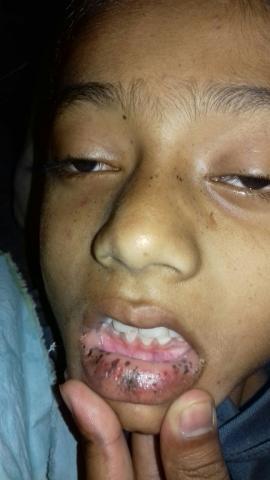Recurrent Intussuption in patient with Peutz-Jeghers syndrome.
Master Hanzla 11year old with presented with repeated attacks of upper intestinal obstruction due to intussussption, treated conservatively improved. CT abdomen revealed intussusption but upon exploration found no intussuption,hence closed. Just after one week patient presented in acute condition with mass left hypochondrium and repeated bilious vomiting. Examination of abdomen remained unremarkable except mild tenderness in left hypochodrium. On redo surgery found jajujajunal intussuption up to DJ flexure. Upon redo of intussuption whole jejunum was viable with a dimple at antimesenteric border. On carefull palpation we found some intra mural mass. On enterotomy we found cauliflower flushy polyp leading cause of repeated attack of intussuption. On further exploration we found multiple intraluminal polyps up to terminal ileum. Short lengths of heavily involved jejunum was resected and primary anastomosis done. Recovery remained unevent full. Histopathalogy awaited. Family History. Mother died due to undiagnosed bleeding per rectum in Sheikh Zayad Lahore. Another younger brother suffering from mucocutaneous patches. Peutz-Jeghers syndrome, also known as hereditary intestinal polyposis syndrome, is an autosomal dominant genetic disease characterized by the development of benign hamartomatous polyps in the gastrointestinal tract and hyperpigmented macules on the lips and oral mucosa (melanosis).[1] Peutz–Jeghers syndrome has an incidence of approximately 1 in 25,000 to 300,000 births.[2] Diagnosis The main criteria for clinical diagnosis are: • Family history • Mucocutaneous lesions causing patches of hyperpigmentation in the mouth and on the hands and feet. The oral pigmentations are the first on the body to appear, and thus play an important part in early diagnosis. Intraorally, they are most frequently seen on the gingiva, hard palate and inside of the cheek. The mucosa of the lower lip is almost invariably involved as well. • Hamartomatous polyps in the gastrointestinal tract. These are benign polyps with an extraordinarily low potential for malignancy. Having 2 of the 3 listed clinical criteria indicates a positive diagnosis. The oral findings are consistent with other conditions, such as Addison's disease and McCune-Albright syndrome, and these should be included in the differential diagnosis. 90-100% of patients with a clinical diagnosis of PJS have a mutation in the STK11/LKB1 gene. Molecular genetic testing for this mutation is available clinically.[3] Genetics In 1998, a gene was found to be associated with the mutation. On chromosome 19, the gene known as STK11 (LKB1)[4] is a possible tumor suppressor gene. It is inherited in an autosomal dominant pattern, which means that anyone who has PJS has a 50% chance of passing the disease on to their offspring.[citation needed] Limited evidence base Peutz–Jeghers syndrome is rare and studies typically include only a small number of patients. Even in those few studies that do contain a large number of patients, the quality of the evidence is limited due to pooling patients from many centers, selection bias (only patients with health problems coming from treatment are included), and historical bias (the patients reported are from a time before advances in the diagnosis of treatment of Peutz–Jeghers syndrome were made). Probably due to this limited evidence base, cancer risk estimates for Peutz–Jeghers syndrome vary from study to study.[5] Presentation The risks associated with this syndrome include a strong tendency of developing cancer in a number of parts of the body.[6] While the hamartomatous polyps themselves only have a small malignant potential (

